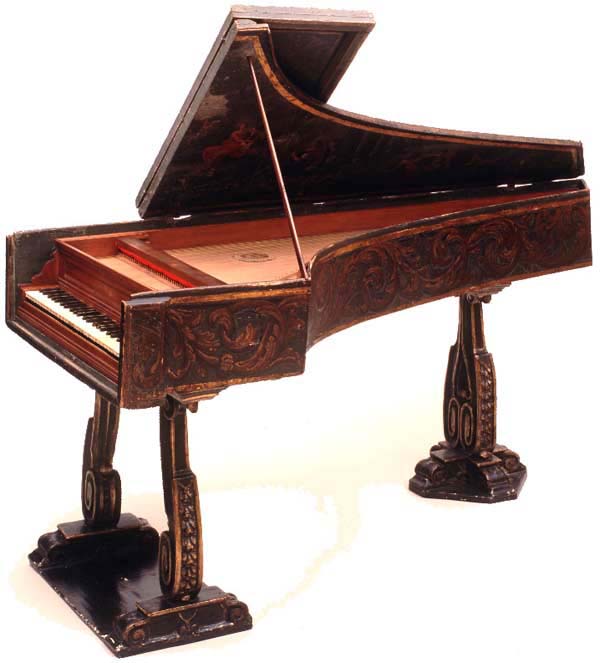![]()
Grant O’Brien
The single-manual harpsichord, undated and formerly thought to be Florentine in origin
One of the little-recognised treasures of the Russell Collection is this small single-manual Italian harpsichord (see Figure 6). Although it now has a compass of C to d3, it originally had the same enharmonic compass as the rectangular virginal by Francesco Poggio discussed above. The instrument has the usual Italian features: a single-manual, string scalings designed for brass stringing, a Gothic rosette in parchment and wood in three separate layers, a separate outer case, and a pungent, vibrant sound.

Figure 6 - Anonymous single-manual harpsichord, c. 1620
Russell Collection of Early Keyboard Instruments, Catalogue No HS1-A1620.2
The instrument has undergone a number of alterations in the historical period in order to change the compass, pitch, disposition and stringing materials. These alterations have been dealt with by John Barnes in a lengthy restoration report held by the Russell Collection. The most recent historical state is that given to it in Florence in the workshops of Cristofori or of one of his pupils. The various features of this state which enable it to be attributed to Cristofori (dealt with elsewhere on this site) include the moulding shapes on the replacement nut, the construction features of the registers and keyboard, and the use of the Florentine soldo in the string scaling design and in the spacing of the jackslots in the registers. Because the instrument was re-worked in Florence it had always previously been assumed that it was also Florentine in origin.
The left-hand diagram in Figure 7 shows the dimensions of the baseboard measured in millimetres and the angle of the tail. The orthogonal components of the tail measurement, and the tangent of the tail angle are in the proportion:
![]()
This immediately suggests a length of the local unit of ![]() mm, and
mm, and ![]() mm as an initial estimate of the unit of measurement used to
design the instrument. When applied to
the instrument as a whole they give the following results:
mm as an initial estimate of the unit of measurement used to
design the instrument. When applied to
the instrument as a whole they give the following results:
Measurement Local Length of
in mm unit oncia
Component of tail parallel to spine: 93 = 4¼ once » 21.88
Component of tail perpendicular to spine: 147 = 6¾ once » 21.78
Length of spine: 1860 = 85 once » 21.88
Baseboard width: 764 = 35 once » 21.83
Length of cheek: 434 = 20 once » 21.70
Maximum
height of case sides:
196 = 9
once
» 21.78
Tota 3494 = 160 once Average: 21.838mm
Table 1
- The calculation of the local unit of
measurement
Anonymous single-manual harpsichord, c. 1620
Russell Collection of Early Keyboard Instruments, Catalogue No HS1-A1620.2
This is very close to the value of the oncia for Naples[14] where one palmo had a length of 262.01mm and when this is divided into 12 once gives an oncia of 21.835mm (the difference is only 0.01%). Thus it is clear that this instrument was originally made in Naples and not in Florence. Hence this instrument, like another single-manual harpsichord in the Royal College of Music in London (click here for a discussion of this instrument), was originally made in Naples and then both instruments were later exported to Florence where they were re-worked by Cristofori.

Figure 7 - Baseboard dimensions without the case sides in mm (left diagram)
and in units of the Neapolitan oncia = 21.813mm (right diagram)
Anonymous single-manual harpsichord, c. 1620
Russell Collection of Early Keyboard Instruments, Catalogue No HS1-A1620.2
This instrument is discussed in more detail elsewhere on this site. Click here for further information.
Footnote:
[14] Both Horace Doursther, Dictionnaire universel des poids et mesures anciens et modernes, (Brussels, 1840) and Giovanni Croci, Dizionario universale dei pesi e delle misure in uso presso gli antichi e moderni con ragguaglio ai pesi e misure del sistema metrico, (The Author, Milan, 1860) give a value 262.01mm for the piede in Naples.